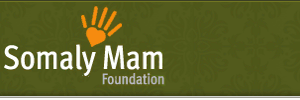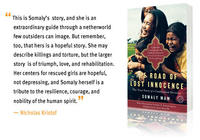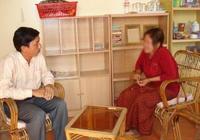Michael Angelo's The Lipstick Portraits
 Michael Angelo at the opening of The Lipstick Portraits
Michael Angelo at the opening of The Lipstick Portraits
Artists and Celebrities Take on Modern Day Slavery
We interview Michael Angelo to get his insight on the making and launch of his groundbreaking exhibit.
Photographer and beauty expert Michael Angelo, whose Wonderland Beauty Parlor in New York is an icon in the industry, is a long-time advocate for victims and survivors of human trafficking.
To raise both awareness and funds for the cause, Angelo has created a series of striking and provocative portraits that stand in solidarity with those enslaved by the sex trade, known as The Lipstick Portraits. He was inspired to create these portraits after reading Mariane Pearl’s description, in Glamour, of Cambodian sexual slavery, in which red lipstick can be understood as a mark of a girl’s enslavement. Angelo later traveled to Cambodia, where he met Somaly Mam and visited the shelters that she established for girls rescued from the brothels.
Recruiting some of the most outspoken and extraordinary people that he knew, including Susan Sarandon, burlesque star Dita Von Teese, actor Alan Cumming, Cambodian Parliamentarian Mu Sochua, and Somaly Mam herself, Angelo created these portraits to call attention to the scourge of sexual slavery. In the series, the red lipstick is symbolically transformed from a tool of cruelty and slavery to one of solidarity and empowerment.
The Lipstick Portraits exhibition opened to the public on May 8 at 401 Projects in New York. Pictures of the event can be found here. Throughout the month of May, the exhibition drove public awareness around the issues and received outstanding reviews and coverage from the media, including Vogue Italia, Change.org’s End Human Trafficking blog, Marie Claire, The Daily Beast, and NPR.
In addition to raising awareness, Angelo is also generously raising funds for the Somaly Mam Foundation. 100% of the proceeds from the sale of The Lipstick Portraits prints, exhibition catalogues, and t-shirts will benefit the Somaly Mam Foundation.
We spoke with Michael Angelo about The Lipstick Portraits, the meaning of beauty, and his mission to help end human trafficking.
We’ve seen the extensive media coverage that the debut of The Lipstick Portraits received. How does it feel to have your work and its bold messages embraced by the media and the public?
It feels fantastic and validating. It was a really risky idea. For as many yeses as I received regarding participation and support, I received 10 nos. Of course, that makes one second-guess oneself, and it’s really incredible to see it complete and, ultimately, well-received.
As The Lipstick Portraits demonstrates, you are an accomplished photographer in addition to being a leader in the beauty industry. What role do you see each playing in furthering your efforts to end human trafficking and sexual slavery?
Both have been incredible tools of communication for me. When I’m working behind the chair as a hairstylist, I have the incredible opportunity to have someone’s ear for as long as two and a half hours. It is a great opportunity to plant seeds and share ideas. When I learned that there were vocational training programs in the field of beauty, I saw a much more literal way for me to use those skills to help. With regard to photography, as they say, a picture is worth a thousand words, and so, for me, using photography was a way to boldly, clearly, and succinctly express all of the ideas that were rolling around in my head. When I looked at the amount of press around The Lipstick Portraits, I realized that I’d started an engaging dialogue about the subject of trafficking, forced prostitution, and slavery in a way that I hope is accessible and engaging.
You’ve said before that these portraits were inspired by an article written by Mariane Pearl in which she describes witnessing very young, made-up girls outside of brothels in Cambodia – the bright red lipstick representing their slavery and stolen childhood. How have your experiences in Cambodia, and with the cause of human trafficking in general, affected your perspectives of beauty?
Funny, beauty…It is such a tricky subject…unlike fashion, which is, by definition, a totally superficial thing. Beauty is different. We are sold ideas and ideals about beauty that are really much closer to fashion. Beauty is so complex. It’s this combination of aesthetics and intelligence and spirit that I personally think equals beauty in its most legitimate sense. It is so often that I have someone come into Wonderland thinking that we sell beauty. But that’s simply not possible. When I work with Somaly and the girls in the shelters, salons and vocational schools I see so much beauty all around. Beauty in the work, healing and growth of these young women. Beauty in seeing the girls cut and color hair. Applying makeup to one another, and learning makeup applications which enhance their features and skin, as opposed to using makeup to make themselves. I suppose to summarize I’d say that through my work with Somaly, I have seen and learned that the “fashion” side of beauty can really be put to great use, and ultimately bring about a beauty that is more than skin deep!
Do you have a story that you can share with us about recruiting your subjects?
I think the most interesting thing about recruiting was that it was a real exercise in humility. I had to learn to accept “no” from people, even if I didn’t like their reason for not wanting to participate. One person told me she wouldn’t participate because she didn’t like the way she looked in red lipstick. It took everything in my power not to shriek at her, “Neither does an eight year-old girl in a cage in a brothel. That’s really not the point.” On the other hand, it was incredibly inspiring to see how many people were willing to lend their image and their reputation to such an important cause. There’s really nothing more beautiful than seeing people band together to help fight this crime against humanity.
You have devoted significant personal time and resources to fighting the scourge of child prostitution and human trafficking, taking both your “heart and hands,” as Somaly Mam often says, to create change. Did you ever hesitate and question the impact that you could have? What advice do you have for other artists and supporters who are thinking about using their talents to support the cause?
About a million and one times throughout the process. It was exhausting. It was frustrating. I had to learn things every day that were not in my field of work. I had to learn how to wrangle a celebrity. I had to learn how to put together a press release. I had to beg, borrow and steal to get this done on a shoestring budget. I had to deal with friends and family and co-workers who were frustrated with my absence. But you know what? I am now able to do more than ever before. I have received notes from people around the world telling me that I inspired them to try something new to help with a cause dear to them. I have been to Cambodia and learned more about world history than I ever would have if I were standing behind a chair doing hair all day. I have established an incredible network of friends and family. I found true love. I got engaged in a rice paddy. So the advice I would give to anyone who is willing to use their tools of self-expression to make a difference in the world is “Don’t give up the fight. It’s not going to be easy, but the most important things in life aren’t.”















Comments
Your talent is only surpassed by the size of your heart ! The portraits are fabulous and so are you ! Love Pat
Post new comment